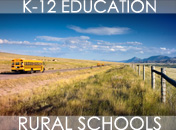
Utah’s rural schools face significant educational challenges. They have greater difficulties than non-rural schools in hiring teachers, finding teachers with specialties, and finding teachers who teach multiple subjects. Rural schools also come up short in offering the wide array of courses that non-rural schools offer.
Yet when we look at rural educational outcomes, we see paradoxes. In the core subjects that the state tests on an annual basis, rural students tend to perform better than non-rural students. Rural students also graduate at a higher rate, though in the past several years this difference has been diminishing. On the other hand, rural students have lower college entrance exam scores and are less likely to enter college.
Rural school principals and superintendents tend to believe that smaller school and classroom environments provide more personal student attention, thus bolstering graduation and core-subject learning. Some of the data that Utah Foundation analyzed in this evaluation justifies these opinions. While rural students are thriving in the basic curriculum and are not dropping out of school, they are not being offered the educational breadth or the depth of advanced courses that non-rural students are, which may be suppressing college enrollment rates.
The process of providing additional funds to rural schools and districts to compensate for their small scale seems to be providing a level of funding that is sufficient and equitable in meeting the basic education of rural students. However, rural principals and superintendents believe that these sources of funding are at risk. Further, they feel that financial constraints are preventing rural students from reaching excellence. By nature of their small size and the resultant financial constraints, rural schools have difficulty providing the course offerings and facilities that rural principals want – that non-rural principals have – which in turn may be holding students back from attaining higher levels of education.
Read the Full Evaluation (131 pages)
Supplemental Materials: Student Health And Risk Prevention (SHARP) surveys by locale code:

